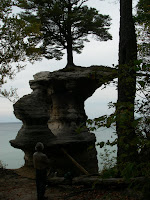Massachusetts
 We kiddy cornered across Massachusetts starting from Nashua, NH, where we entered from north easterly in order to miss the Boston traffic, and emerged at Mt. Washington, at the extreme south-west corner, after just two days. It’s a nice state, with the old stone walls, lots of lofty steeples and sturdy, interesting architecture, but it’s also short of public/wild space. The traffic in towns like Amherst made it impossible to even zero in on where the Emily Dickinson Homestead was. We just wanted to get through there. The state parks and wild lands are mostly in the western part of the state, in the beautiful Berkshires. I realize that Massachusetts is rich in culture, knowledge and good human energies. The trip has shaped itself into a quest for wild country in the previously undefined hope that there really is still a balance and salvation from human overpopulation and overuse. Massachusetts is old enough to know how to create and maintain quality life styles for a quasi-rural majority (that is only in terms of land mass, maybe the cities are more wounded…) Still, it’s not enough…there isn’t enough habitat to support a diversity and numbers of wildlife, at least that’s how it seems. I can’t imagine how impacted all the areas we have visited in October must be in the summer and wouldn’t want to find out.
We kiddy cornered across Massachusetts starting from Nashua, NH, where we entered from north easterly in order to miss the Boston traffic, and emerged at Mt. Washington, at the extreme south-west corner, after just two days. It’s a nice state, with the old stone walls, lots of lofty steeples and sturdy, interesting architecture, but it’s also short of public/wild space. The traffic in towns like Amherst made it impossible to even zero in on where the Emily Dickinson Homestead was. We just wanted to get through there. The state parks and wild lands are mostly in the western part of the state, in the beautiful Berkshires. I realize that Massachusetts is rich in culture, knowledge and good human energies. The trip has shaped itself into a quest for wild country in the previously undefined hope that there really is still a balance and salvation from human overpopulation and overuse. Massachusetts is old enough to know how to create and maintain quality life styles for a quasi-rural majority (that is only in terms of land mass, maybe the cities are more wounded…) Still, it’s not enough…there isn’t enough habitat to support a diversity and numbers of wildlife, at least that’s how it seems. I can’t imagine how impacted all the areas we have visited in October must be in the summer and wouldn’t want to find out.
We were almost to the summit of Mt. Everett (2602 ft.) when Sasha got porcupine quilled again. This was the third time it’s happened and even though we tried xylocaine gel on her muzzle, it seemed like the battle to remove the quills with the pliers was more hard fought than the previous times. We were drained afterwards and wondering how to allow her freedom for the rest of the porcupine’s range. I’m including a photo of quills…they look pretty benign once out of the dog’s face.

I’m also putting in a photo of Bash-Bish falls, right on the border of the three states.
We re-entered New York State there, right at the Connecticut, Massachusetts intersection and headed toward the Catskills which extend almost to the Pennsylvania border at their tip, but with rain and early darkness we made it only as far as the Wal-Mart parking lot in the town of Catskill.
 We'll be following the Appalachian Trail south now if the luck and health of the veggie voyage stays with us.
We'll be following the Appalachian Trail south now if the luck and health of the veggie voyage stays with us.














































